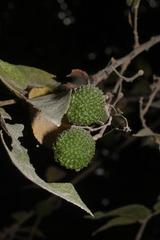
Neotropical Flora
|
Family: Malvaceae
[Guazuma guazuma (L.) Kuntze] |
Lam., Encycl. Méth. Bot. 3:52.1789 Tree, generally 6-25 m tall; trunk to 60 cm dbh; stems, petioles, lower leaf surfaces, and axes of inflorescences densely stellate-tomentose. Stipules minute, caducous; petioles 5-20 mm long; blades lanceolate, acuminate, rounded to cordate and oblique at base, 6-16 cm long, 2-6 cm wide, glabrate or more often stellate-puberulent on both surfaces, the margins irregularly and finely toothed; palmate veins at base 3-7. Flowers in short, loose, axillary, thyrsiform clusters; pedicels 3-6 mm long; sepals 3, yellow, unequal, stellate-puberulent outside, recurved at anthesis; petals 5, obovate, ca 2.5 mm high, yellowish-green, hooded and bifid at apex, fused to free part of filament, the claw red with several red lines extending up petals, the appendage of the petal deeply bifid, ca 4 mm long; stamens 15, in 5 groups of 3 each, opposite petals, the staminal tube minute, red; pistil minute; staminodia 5, triangular, alternate with petals. Fruits globose to oval, 2-4 cm long, indehiscent or opening partway along 4 or 5, +/- regular, longitudinal fissures, covered with many stout brown tubercles, the tubercles separating at maturity to expose the irregularly porate white surface; seeds numerous, irregularly ovoid, 2.5-3.5 mm long, borne among the fibrous inner parts, apparently falling through the holes in the exocarp, the testa maculate, covered by a membrane, the membrane very thin, mucilaginous and very sticky when wet. Croat 6780, 8484. Uncommon, in the forest and at the edge of the Laboratory Clearing. Flowers mostly from March to May and from September to November. The fruits have been seen from March to May and in September. |
|
|
|
Powered by Symbiota.










































































